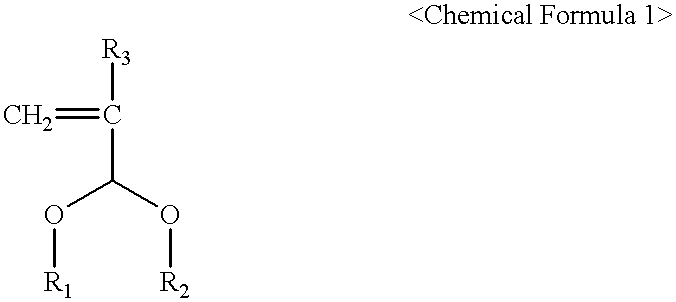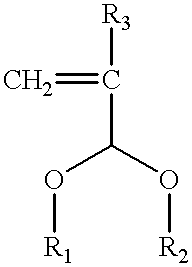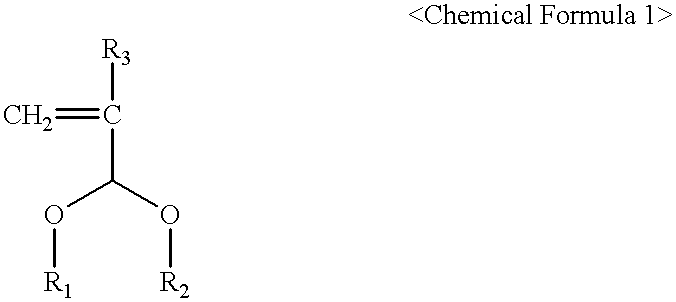Photoresist cross-linker and photoresist composition comprising the same
a cross-linking agent and cross-linking technology, applied in the field of cross-linking agents, can solve the problems of high energy light exposure, shortening the life of the cross-linking agent, and large amount of acid generated
- Summary
- Abstract
- Description
- Claims
- Application Information
AI Technical Summary
Benefits of technology
Problems solved by technology
Method used
Image
Examples
example 1
Synthesis of Poly(3,3-dimethoxypropene)
Acrolein (30 g) represented by Chemical Formula 4 below, AIBN (0.6 g) and tetrahydrofuran (75 g) were placed in a 200 ml flask, and reacted at 65.degree. C. under nitrogen or argon atmosphere for 8 hours. After the polymerization was completed, polyacrolein was precipitated from ethyl ether (yield: 60%).
Polyacrolein thus obtained (20 g) and methanol (200 g) were placed in a 500-ml round-bottomed flask, and closely mixed. Trifluoromethanesulfonic acid (0.5 g) was added thereto, and the resultant mixture was heated under reflux at 80.degree. C. for 24 hours, then neutralized to pH 7-8 using TMAH solution. Then, the reaction mixture was concentrated by using a rotary evaporator, and the residue was precipitated from distilled water. The precipitate was dried in vacuo to obtain poly(3,3-dimethoxypropene) resin of Chemical Formula 5 (yield: 60%). The compound of Chemical Formula 5 was confirmed on an NMR spectrum thereof by the disappearance of an a...
example 2
Synthesis of Poly(3,3-dimethoxypropene / acrylic acid)
Acrolein of Chemical Formula 4 (30 g), acrylic acid (3 g), AIBN (0.66 g) and tetrahydrofuran (80 g) were placed in a 200 ml flask, and the mixture was reacted at 60.degree. C. under nitrogen or argon atmosphere for 8 hours. After the polymerization was completed, polymers were obtained by precipitating from water (16 g, yield: 50%) The polymers thus obtained (16 g) and methanol (300 g) were placed in a round-bottomed flask, and closely mixed. Trifluoromethanesulfonic acid (0.8 ml) was added thereto, and the resultant mixture was heated under reflux at 80.degree. C. for 8 hours, then neutralized to pH 7-8 using TMAH solution. Then, the reaction mixture was concentrated by using a rotary evaporator, and the resultant solution was dissolved in chloroform (300 g). The solution was placed in a separating funnel, and distilled water (300 g) was added thereto. Then the distilled water layer was separated and concentrated by evaporation un...
example 3
Synthesis of Poly(3,3-diethoxypropene)
The procedure according to Example 1 was repeated but using ethanol instead of methanol, to obtain the compound represented by Chemical Formula 7, poly(3,3-diethoxypropene) (yield: 67%). ##STR10##
In the formula, n represents the number of monomers participating in the homopolymerization.
PUM
| Property | Measurement | Unit |
|---|---|---|
| wavelength | aaaaa | aaaaa |
| alkaline | aaaaa | aaaaa |
| semiconductor | aaaaa | aaaaa |
Abstract
Description
Claims
Application Information
 Login to View More
Login to View More - R&D
- Intellectual Property
- Life Sciences
- Materials
- Tech Scout
- Unparalleled Data Quality
- Higher Quality Content
- 60% Fewer Hallucinations
Browse by: Latest US Patents, China's latest patents, Technical Efficacy Thesaurus, Application Domain, Technology Topic, Popular Technical Reports.
© 2025 PatSnap. All rights reserved.Legal|Privacy policy|Modern Slavery Act Transparency Statement|Sitemap|About US| Contact US: help@patsnap.com



